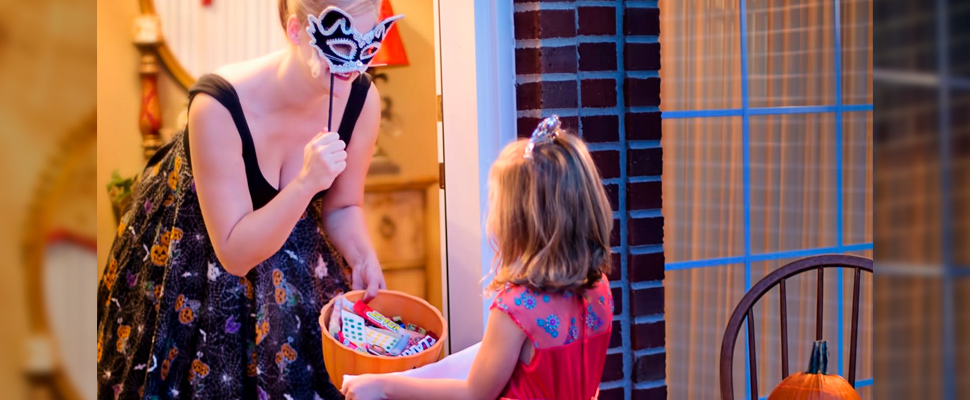Find out how Halloween is celebrated around the world
Beyond dressing up and eating candy, Halloween is a celebration that honors the dead and has an impact on different cultures.

Woman delivering candy to a girl on Halloween. / Photo: Pexels – Reference Image
LatinAmerican Post | Juliana Suárez
Listen to this article
Leer en español: Descubre cómo se celebra Halloween en el mundo
With the arrival of Halloween, we take the opportunity to get out, share with our friends and family and eat lots of sweets. But the celebration goes beyond looking for the perfect costume of the most popular movie of the year; it is a celebration that honors the dead and has an impact on different cultures.
Halloween, All Saints' Day or Day of the Dead (depending on the tradition) originated with the Celts in the Iron Age (1200 to 400 BC) and was known as a pagan festival called Samhain. This day was considered by the Celts the beginning of a new year and was celebrated at this time because it coincided with the fruits of the crops.
Later it was consolidated as a Catholic celebration called All Saints' Day, in which these important figures were honored for the Catholic religion: it is celebrated to commemorate everyone who already enjoys eternal life. This day is November 1, and the night before, October 31, and worldwide known as Halloween is "All Hallows Eve", hence the name derives.
But Halloween as we know it today where children go out to ask for sweets and witches, ghosts and pumpkins take the streets, it is an adaptation of all that for years was consolidated by different European groups (both the Celts and the Catholic religion).
The 'trick-or-treating' -the tradition of asking for sweets- was adapted in the United States from those customs that were already there and transformed October 31 in a neighboring day, where children and adults from the neighborhoods could go out to playing; interacting and exchanging sweets is the symbol that unites communities. Parties and creative costumes are just one more way to share and celebrate this day.
Today there are still some traditional celebrations around the world. In LatinAmerican Post we tell you some of them so that, if you like them, assemble your next trip to these places on this special date.
Europe
In general, the celebration in Europe is less and less rooted in its traditions and more similar to the American adaptation with costume parties, sweets and 'trick-or-treating'.
It is also an opportunity to taste typical dishes that only exist at this time of year, for example, in Italy. On All Saints' Day, called Ognissanti, processions are held to cemeteries to honor people who have died. Afterward, a big family dinner with typical Italian dishes with exclusive touches of the celebration is tradition: risotto or pasta with pumpkin and the famous dead bread (pane morto), a sweet bread based on cinnamon, chocolate, and dried fruits.
Another special celebration in Europe occurs in Spain. In Catalonia, events similar to that of Italy are held, where everything revolves around the family and typical Catalan dishes. Meanwhile, Galicia retains the oldest tradition: the Samhain. On this day they celebrate with special dishes and drinks and gather around bonfires, fireworks and celebrate as the Celts did.
U.S
It is perhaps the place in the world where Halloween is most celebrated and the reason we know the holiday as we see it today. Far from religious or cultural traditions, American Halloween revolves around candy, costumes, and parties with family and friends.
On this day, October 31, terror is the main element, so it is usual to see houses of terror that invite challenges. There is currently a house of terror in Tennesse that promises to be so scary that its owner offers USD 20,000 to who is able to finish the tour (which includes lasting 10 hours immersed in the terrifying house). Mckamey Manor Dystopia promises to be a challenge for any adrenaline lover.
Among other conditions that visitors must meet in order to enter this particular mansion, is to pass an exam that determines their good physical and mental health.
Read also: Visit 5 World Heritage towns in Latin America
Mexico
The place par excellence where this day is celebrated in a traditional way is Mexico with the Day of the Dead. The Mexicans created their own holiday and it is now a characteristic celebration of culture. Derived from traditional All Saints' Day in Latin America and in general in countries with a Catholic impact, the Day of the Dead is celebrated on November 2 but the whole month of October is full of small samples of celebration in each region of the country and Vespers are celebrated with all the possible cultural tradition.
With significant altars of family members and special people who have died, Mexicans gather in a kind of rites to honor them. The days before, the main streets of the city, such as Av. Paseo de la Reforma in Mexico City, become parade stages where Catrinas predominate, the Mexican skulls known for their festive colors that show death as one more party to honor all who are gone.
The same happens in the most traditional villages of the country, where people take to the streets to celebrate this traditional day.





